Digitalization Process, Benefits, Drivers and Barriers in Business
VerifiedAdded on 2023/01/12
|12
|3631
|72
Report
AI Summary
This report provides a comprehensive overview of the digitalization process within a business context. It begins by defining digitalization and its role in transforming how organizations operate, emphasizing the integration of digital technology to improve efficiency and communication. The report then delves into the importance of digitalization, highlighting benefits such as enhanced collaboration, improved operational efficiency, and better customer service. It also identifies key drivers of digitalization, including customer expectations, the need for faster production, and the advantages of artificial intelligence. Furthermore, the report discusses the implementation of digitalization procedures and potential barriers to adoption, such as the need for investment, and the importance of considering customer needs and technological advancements. Overall, the report underscores the critical role of digitalization in achieving a competitive advantage in the global market.

Global Business and Sustainability
Paraphrase This Document
Need a fresh take? Get an instant paraphrase of this document with our AI Paraphraser
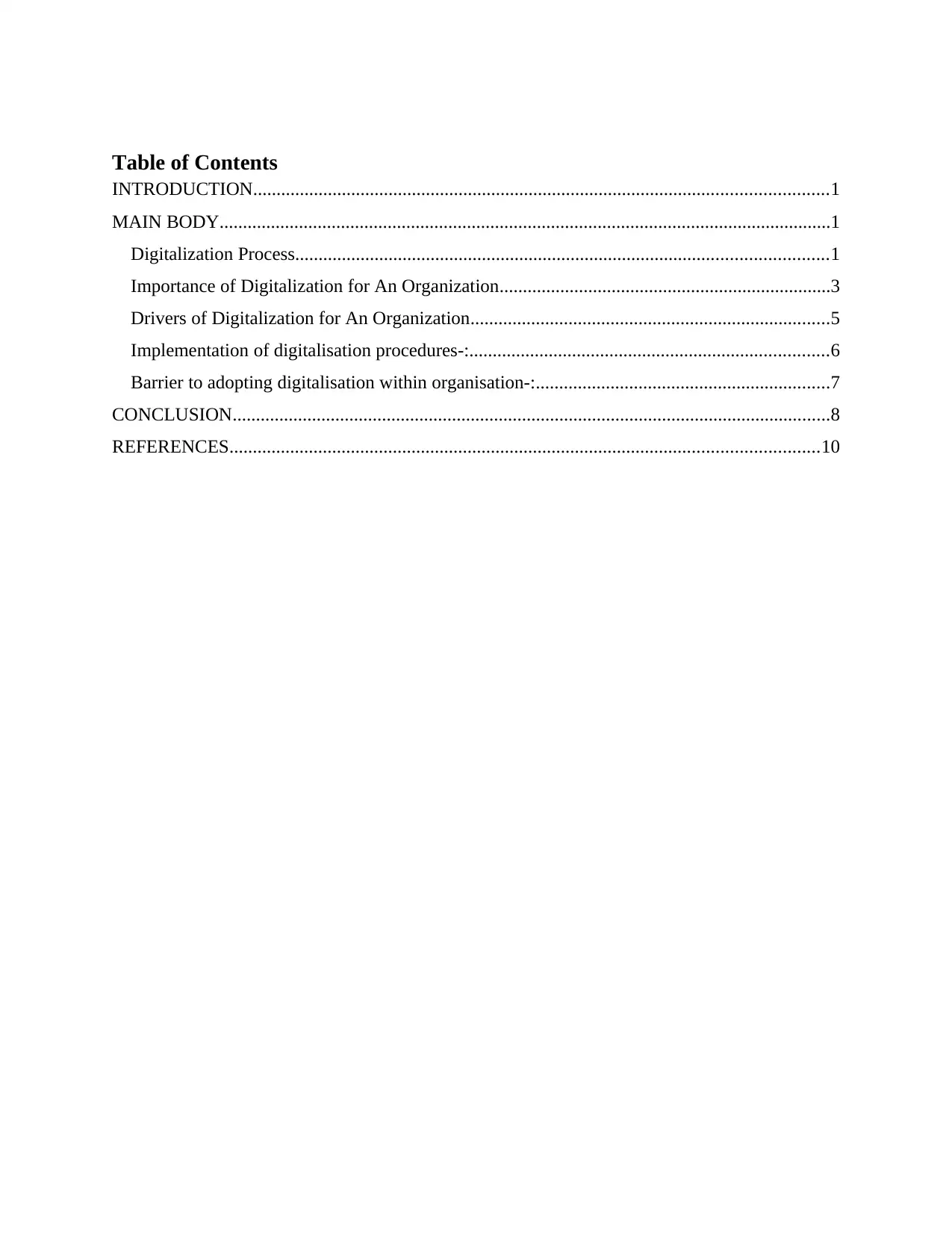
Table of Contents
INTRODUCTION...........................................................................................................................1
MAIN BODY...................................................................................................................................1
Digitalization Process..................................................................................................................1
Importance of Digitalization for An Organization.......................................................................3
Drivers of Digitalization for An Organization.............................................................................5
Implementation of digitalisation procedures-:.............................................................................6
Barrier to adopting digitalisation within organisation-:...............................................................7
CONCLUSION................................................................................................................................8
REFERENCES..............................................................................................................................10
INTRODUCTION...........................................................................................................................1
MAIN BODY...................................................................................................................................1
Digitalization Process..................................................................................................................1
Importance of Digitalization for An Organization.......................................................................3
Drivers of Digitalization for An Organization.............................................................................5
Implementation of digitalisation procedures-:.............................................................................6
Barrier to adopting digitalisation within organisation-:...............................................................7
CONCLUSION................................................................................................................................8
REFERENCES..............................................................................................................................10
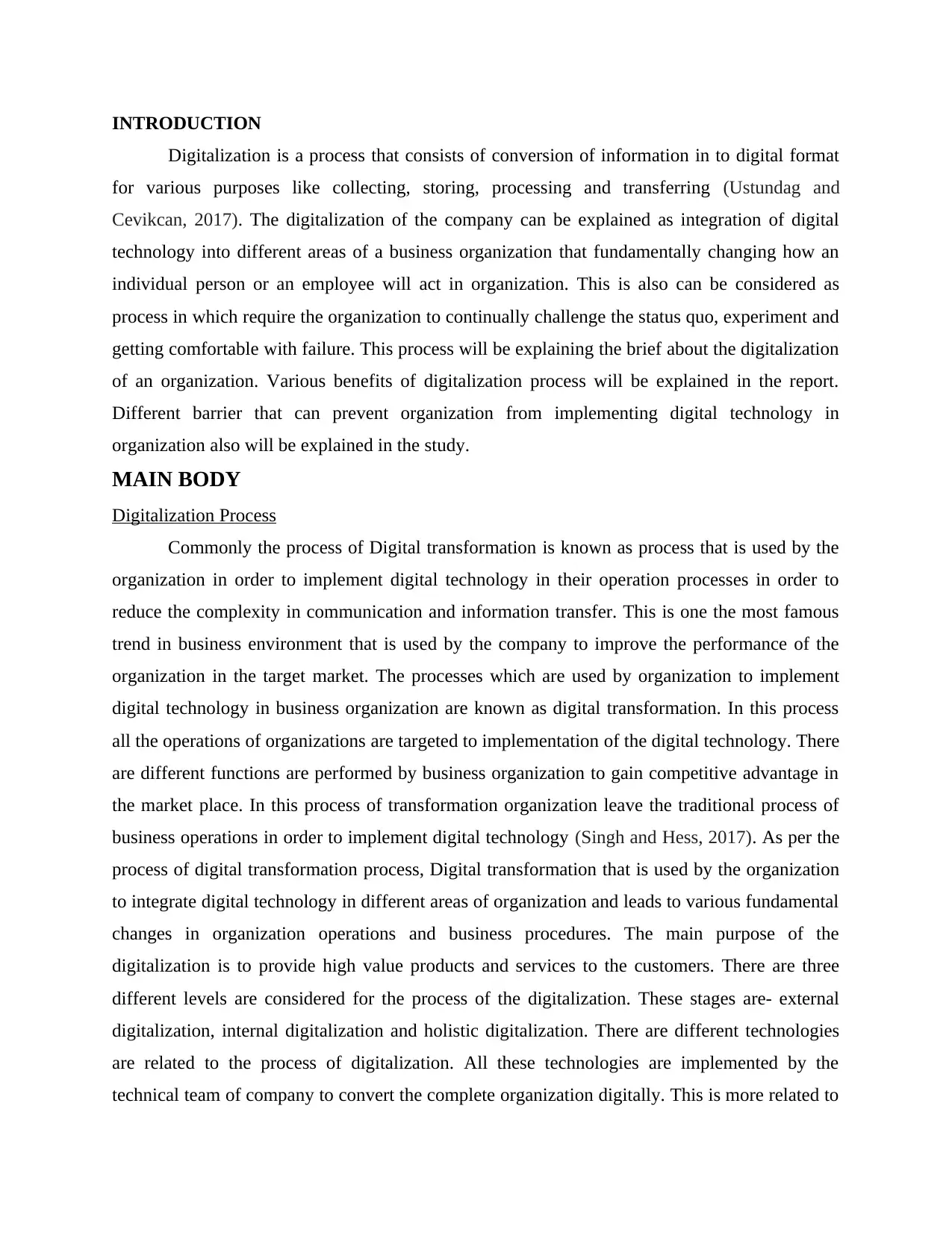
INTRODUCTION
Digitalization is a process that consists of conversion of information in to digital format
for various purposes like collecting, storing, processing and transferring (Ustundag and
Cevikcan, 2017). The digitalization of the company can be explained as integration of digital
technology into different areas of a business organization that fundamentally changing how an
individual person or an employee will act in organization. This is also can be considered as
process in which require the organization to continually challenge the status quo, experiment and
getting comfortable with failure. This process will be explaining the brief about the digitalization
of an organization. Various benefits of digitalization process will be explained in the report.
Different barrier that can prevent organization from implementing digital technology in
organization also will be explained in the study.
MAIN BODY
Digitalization Process
Commonly the process of Digital transformation is known as process that is used by the
organization in order to implement digital technology in their operation processes in order to
reduce the complexity in communication and information transfer. This is one the most famous
trend in business environment that is used by the company to improve the performance of the
organization in the target market. The processes which are used by organization to implement
digital technology in business organization are known as digital transformation. In this process
all the operations of organizations are targeted to implementation of the digital technology. There
are different functions are performed by business organization to gain competitive advantage in
the market place. In this process of transformation organization leave the traditional process of
business operations in order to implement digital technology (Singh and Hess, 2017). As per the
process of digital transformation process, Digital transformation that is used by the organization
to integrate digital technology in different areas of organization and leads to various fundamental
changes in organization operations and business procedures. The main purpose of the
digitalization is to provide high value products and services to the customers. There are three
different levels are considered for the process of the digitalization. These stages are- external
digitalization, internal digitalization and holistic digitalization. There are different technologies
are related to the process of digitalization. All these technologies are implemented by the
technical team of company to convert the complete organization digitally. This is more related to
Digitalization is a process that consists of conversion of information in to digital format
for various purposes like collecting, storing, processing and transferring (Ustundag and
Cevikcan, 2017). The digitalization of the company can be explained as integration of digital
technology into different areas of a business organization that fundamentally changing how an
individual person or an employee will act in organization. This is also can be considered as
process in which require the organization to continually challenge the status quo, experiment and
getting comfortable with failure. This process will be explaining the brief about the digitalization
of an organization. Various benefits of digitalization process will be explained in the report.
Different barrier that can prevent organization from implementing digital technology in
organization also will be explained in the study.
MAIN BODY
Digitalization Process
Commonly the process of Digital transformation is known as process that is used by the
organization in order to implement digital technology in their operation processes in order to
reduce the complexity in communication and information transfer. This is one the most famous
trend in business environment that is used by the company to improve the performance of the
organization in the target market. The processes which are used by organization to implement
digital technology in business organization are known as digital transformation. In this process
all the operations of organizations are targeted to implementation of the digital technology. There
are different functions are performed by business organization to gain competitive advantage in
the market place. In this process of transformation organization leave the traditional process of
business operations in order to implement digital technology (Singh and Hess, 2017). As per the
process of digital transformation process, Digital transformation that is used by the organization
to integrate digital technology in different areas of organization and leads to various fundamental
changes in organization operations and business procedures. The main purpose of the
digitalization is to provide high value products and services to the customers. There are three
different levels are considered for the process of the digitalization. These stages are- external
digitalization, internal digitalization and holistic digitalization. There are different technologies
are related to the process of digitalization. All these technologies are implemented by the
technical team of company to convert the complete organization digitally. This is more related to
⊘ This is a preview!⊘
Do you want full access?
Subscribe today to unlock all pages.

Trusted by 1+ million students worldwide
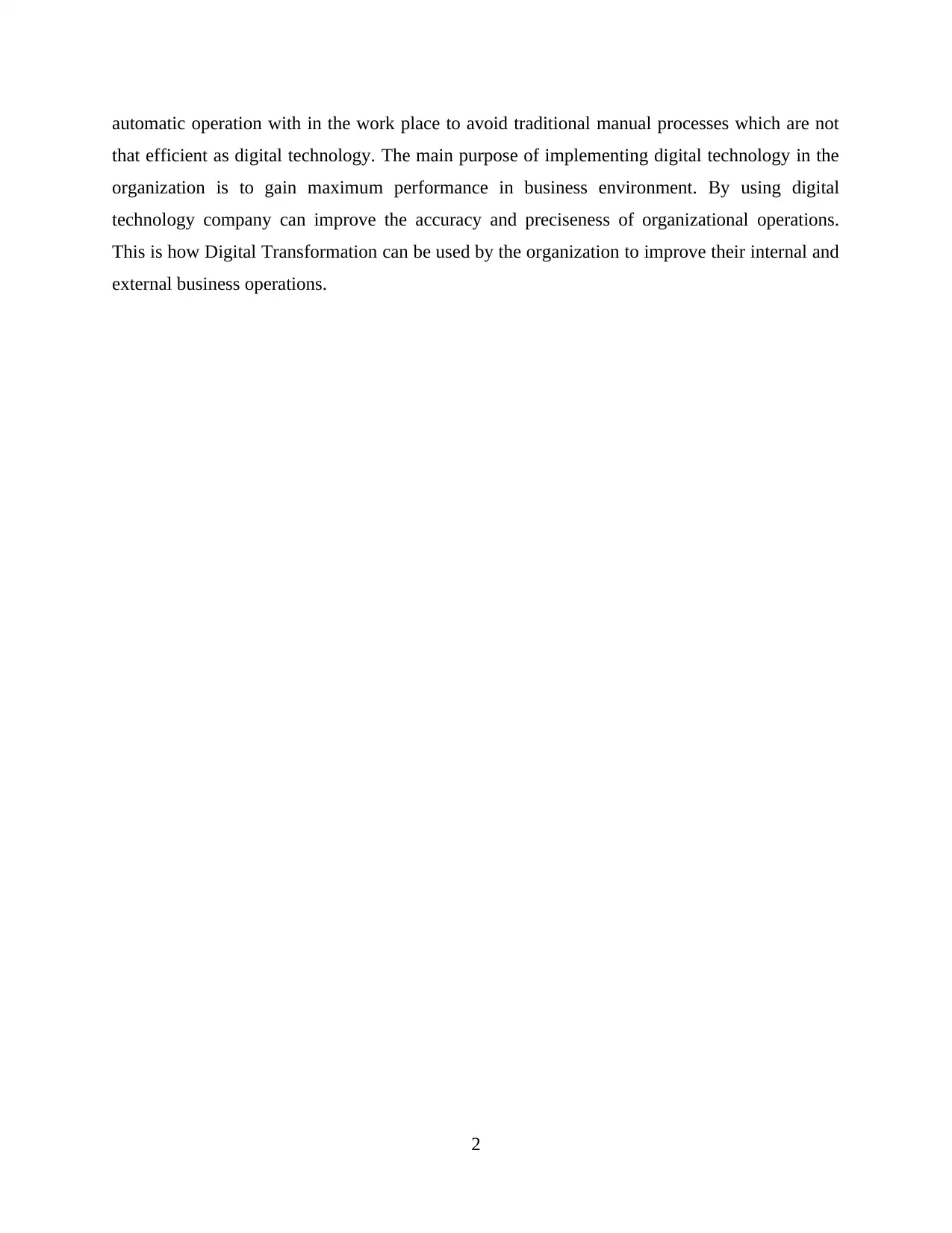
automatic operation with in the work place to avoid traditional manual processes which are not
that efficient as digital technology. The main purpose of implementing digital technology in the
organization is to gain maximum performance in business environment. By using digital
technology company can improve the accuracy and preciseness of organizational operations.
This is how Digital Transformation can be used by the organization to improve their internal and
external business operations.
2
that efficient as digital technology. The main purpose of implementing digital technology in the
organization is to gain maximum performance in business environment. By using digital
technology company can improve the accuracy and preciseness of organizational operations.
This is how Digital Transformation can be used by the organization to improve their internal and
external business operations.
2
Paraphrase This Document
Need a fresh take? Get an instant paraphrase of this document with our AI Paraphraser
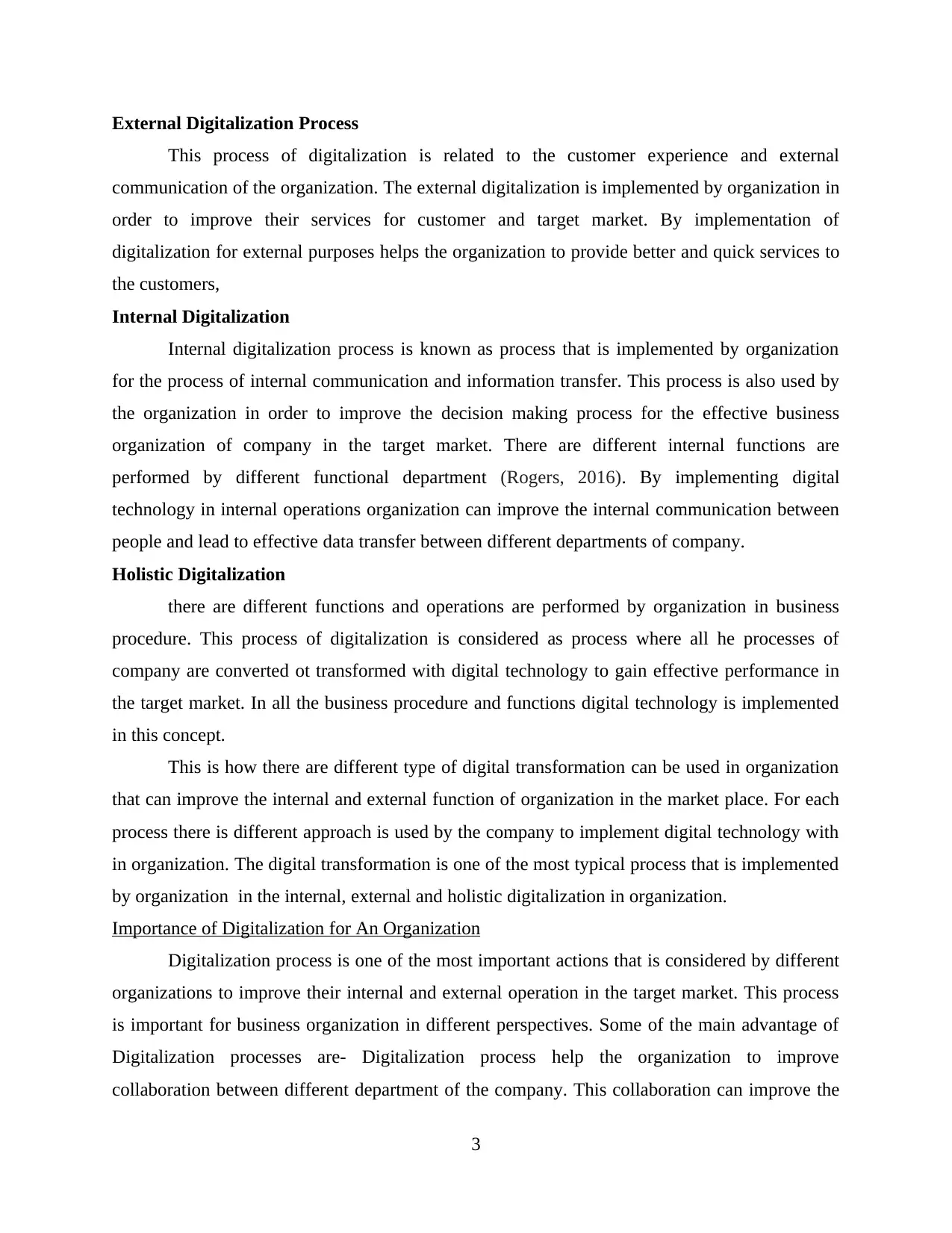
External Digitalization Process
This process of digitalization is related to the customer experience and external
communication of the organization. The external digitalization is implemented by organization in
order to improve their services for customer and target market. By implementation of
digitalization for external purposes helps the organization to provide better and quick services to
the customers,
Internal Digitalization
Internal digitalization process is known as process that is implemented by organization
for the process of internal communication and information transfer. This process is also used by
the organization in order to improve the decision making process for the effective business
organization of company in the target market. There are different internal functions are
performed by different functional department (Rogers, 2016). By implementing digital
technology in internal operations organization can improve the internal communication between
people and lead to effective data transfer between different departments of company.
Holistic Digitalization
there are different functions and operations are performed by organization in business
procedure. This process of digitalization is considered as process where all he processes of
company are converted ot transformed with digital technology to gain effective performance in
the target market. In all the business procedure and functions digital technology is implemented
in this concept.
This is how there are different type of digital transformation can be used in organization
that can improve the internal and external function of organization in the market place. For each
process there is different approach is used by the company to implement digital technology with
in organization. The digital transformation is one of the most typical process that is implemented
by organization in the internal, external and holistic digitalization in organization.
Importance of Digitalization for An Organization
Digitalization process is one of the most important actions that is considered by different
organizations to improve their internal and external operation in the target market. This process
is important for business organization in different perspectives. Some of the main advantage of
Digitalization processes are- Digitalization process help the organization to improve
collaboration between different department of the company. This collaboration can improve the
3
This process of digitalization is related to the customer experience and external
communication of the organization. The external digitalization is implemented by organization in
order to improve their services for customer and target market. By implementation of
digitalization for external purposes helps the organization to provide better and quick services to
the customers,
Internal Digitalization
Internal digitalization process is known as process that is implemented by organization
for the process of internal communication and information transfer. This process is also used by
the organization in order to improve the decision making process for the effective business
organization of company in the target market. There are different internal functions are
performed by different functional department (Rogers, 2016). By implementing digital
technology in internal operations organization can improve the internal communication between
people and lead to effective data transfer between different departments of company.
Holistic Digitalization
there are different functions and operations are performed by organization in business
procedure. This process of digitalization is considered as process where all he processes of
company are converted ot transformed with digital technology to gain effective performance in
the target market. In all the business procedure and functions digital technology is implemented
in this concept.
This is how there are different type of digital transformation can be used in organization
that can improve the internal and external function of organization in the market place. For each
process there is different approach is used by the company to implement digital technology with
in organization. The digital transformation is one of the most typical process that is implemented
by organization in the internal, external and holistic digitalization in organization.
Importance of Digitalization for An Organization
Digitalization process is one of the most important actions that is considered by different
organizations to improve their internal and external operation in the target market. This process
is important for business organization in different perspectives. Some of the main advantage of
Digitalization processes are- Digitalization process help the organization to improve
collaboration between different department of the company. This collaboration can improve the
3
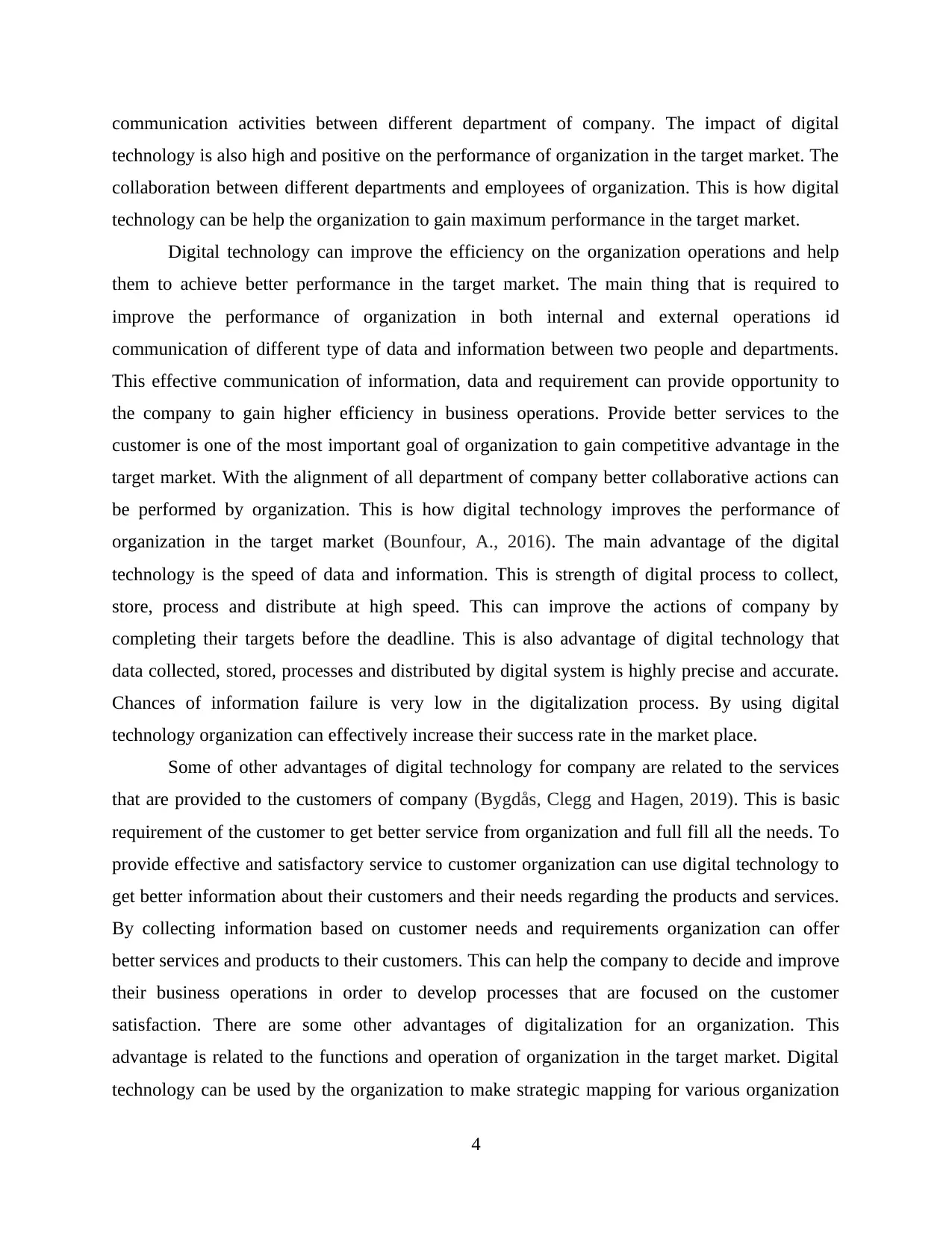
communication activities between different department of company. The impact of digital
technology is also high and positive on the performance of organization in the target market. The
collaboration between different departments and employees of organization. This is how digital
technology can be help the organization to gain maximum performance in the target market.
Digital technology can improve the efficiency on the organization operations and help
them to achieve better performance in the target market. The main thing that is required to
improve the performance of organization in both internal and external operations id
communication of different type of data and information between two people and departments.
This effective communication of information, data and requirement can provide opportunity to
the company to gain higher efficiency in business operations. Provide better services to the
customer is one of the most important goal of organization to gain competitive advantage in the
target market. With the alignment of all department of company better collaborative actions can
be performed by organization. This is how digital technology improves the performance of
organization in the target market (Bounfour, A., 2016). The main advantage of the digital
technology is the speed of data and information. This is strength of digital process to collect,
store, process and distribute at high speed. This can improve the actions of company by
completing their targets before the deadline. This is also advantage of digital technology that
data collected, stored, processes and distributed by digital system is highly precise and accurate.
Chances of information failure is very low in the digitalization process. By using digital
technology organization can effectively increase their success rate in the market place.
Some of other advantages of digital technology for company are related to the services
that are provided to the customers of company (Bygdås, Clegg and Hagen, 2019). This is basic
requirement of the customer to get better service from organization and full fill all the needs. To
provide effective and satisfactory service to customer organization can use digital technology to
get better information about their customers and their needs regarding the products and services.
By collecting information based on customer needs and requirements organization can offer
better services and products to their customers. This can help the company to decide and improve
their business operations in order to develop processes that are focused on the customer
satisfaction. There are some other advantages of digitalization for an organization. This
advantage is related to the functions and operation of organization in the target market. Digital
technology can be used by the organization to make strategic mapping for various organization
4
technology is also high and positive on the performance of organization in the target market. The
collaboration between different departments and employees of organization. This is how digital
technology can be help the organization to gain maximum performance in the target market.
Digital technology can improve the efficiency on the organization operations and help
them to achieve better performance in the target market. The main thing that is required to
improve the performance of organization in both internal and external operations id
communication of different type of data and information between two people and departments.
This effective communication of information, data and requirement can provide opportunity to
the company to gain higher efficiency in business operations. Provide better services to the
customer is one of the most important goal of organization to gain competitive advantage in the
target market. With the alignment of all department of company better collaborative actions can
be performed by organization. This is how digital technology improves the performance of
organization in the target market (Bounfour, A., 2016). The main advantage of the digital
technology is the speed of data and information. This is strength of digital process to collect,
store, process and distribute at high speed. This can improve the actions of company by
completing their targets before the deadline. This is also advantage of digital technology that
data collected, stored, processes and distributed by digital system is highly precise and accurate.
Chances of information failure is very low in the digitalization process. By using digital
technology organization can effectively increase their success rate in the market place.
Some of other advantages of digital technology for company are related to the services
that are provided to the customers of company (Bygdås, Clegg and Hagen, 2019). This is basic
requirement of the customer to get better service from organization and full fill all the needs. To
provide effective and satisfactory service to customer organization can use digital technology to
get better information about their customers and their needs regarding the products and services.
By collecting information based on customer needs and requirements organization can offer
better services and products to their customers. This can help the company to decide and improve
their business operations in order to develop processes that are focused on the customer
satisfaction. There are some other advantages of digitalization for an organization. This
advantage is related to the functions and operation of organization in the target market. Digital
technology can be used by the organization to make strategic mapping for various organization
4
⊘ This is a preview!⊘
Do you want full access?
Subscribe today to unlock all pages.

Trusted by 1+ million students worldwide
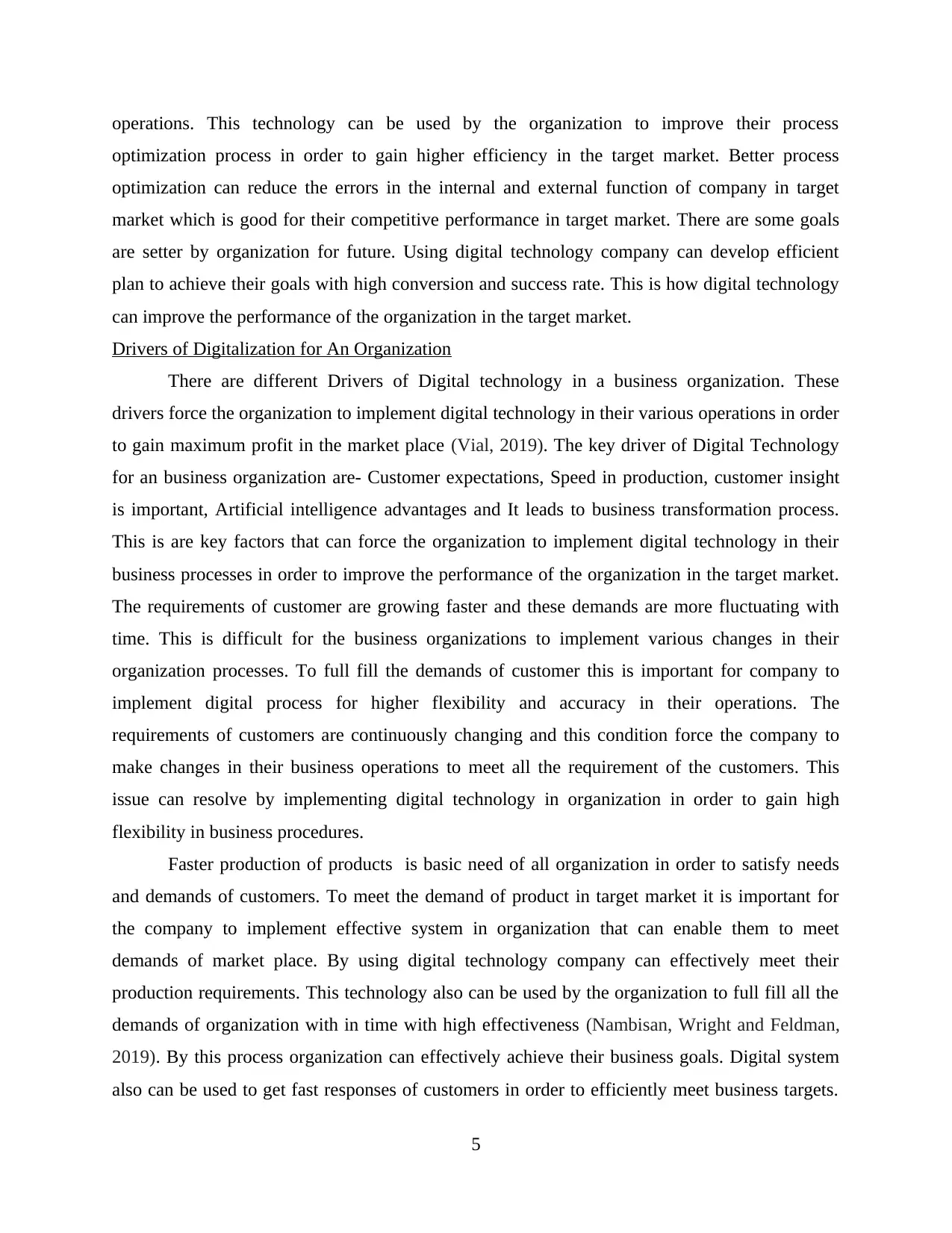
operations. This technology can be used by the organization to improve their process
optimization process in order to gain higher efficiency in the target market. Better process
optimization can reduce the errors in the internal and external function of company in target
market which is good for their competitive performance in target market. There are some goals
are setter by organization for future. Using digital technology company can develop efficient
plan to achieve their goals with high conversion and success rate. This is how digital technology
can improve the performance of the organization in the target market.
Drivers of Digitalization for An Organization
There are different Drivers of Digital technology in a business organization. These
drivers force the organization to implement digital technology in their various operations in order
to gain maximum profit in the market place (Vial, 2019). The key driver of Digital Technology
for an business organization are- Customer expectations, Speed in production, customer insight
is important, Artificial intelligence advantages and It leads to business transformation process.
This is are key factors that can force the organization to implement digital technology in their
business processes in order to improve the performance of the organization in the target market.
The requirements of customer are growing faster and these demands are more fluctuating with
time. This is difficult for the business organizations to implement various changes in their
organization processes. To full fill the demands of customer this is important for company to
implement digital process for higher flexibility and accuracy in their operations. The
requirements of customers are continuously changing and this condition force the company to
make changes in their business operations to meet all the requirement of the customers. This
issue can resolve by implementing digital technology in organization in order to gain high
flexibility in business procedures.
Faster production of products is basic need of all organization in order to satisfy needs
and demands of customers. To meet the demand of product in target market it is important for
the company to implement effective system in organization that can enable them to meet
demands of market place. By using digital technology company can effectively meet their
production requirements. This technology also can be used by the organization to full fill all the
demands of organization with in time with high effectiveness (Nambisan, Wright and Feldman,
2019). By this process organization can effectively achieve their business goals. Digital system
also can be used to get fast responses of customers in order to efficiently meet business targets.
5
optimization process in order to gain higher efficiency in the target market. Better process
optimization can reduce the errors in the internal and external function of company in target
market which is good for their competitive performance in target market. There are some goals
are setter by organization for future. Using digital technology company can develop efficient
plan to achieve their goals with high conversion and success rate. This is how digital technology
can improve the performance of the organization in the target market.
Drivers of Digitalization for An Organization
There are different Drivers of Digital technology in a business organization. These
drivers force the organization to implement digital technology in their various operations in order
to gain maximum profit in the market place (Vial, 2019). The key driver of Digital Technology
for an business organization are- Customer expectations, Speed in production, customer insight
is important, Artificial intelligence advantages and It leads to business transformation process.
This is are key factors that can force the organization to implement digital technology in their
business processes in order to improve the performance of the organization in the target market.
The requirements of customer are growing faster and these demands are more fluctuating with
time. This is difficult for the business organizations to implement various changes in their
organization processes. To full fill the demands of customer this is important for company to
implement digital process for higher flexibility and accuracy in their operations. The
requirements of customers are continuously changing and this condition force the company to
make changes in their business operations to meet all the requirement of the customers. This
issue can resolve by implementing digital technology in organization in order to gain high
flexibility in business procedures.
Faster production of products is basic need of all organization in order to satisfy needs
and demands of customers. To meet the demand of product in target market it is important for
the company to implement effective system in organization that can enable them to meet
demands of market place. By using digital technology company can effectively meet their
production requirements. This technology also can be used by the organization to full fill all the
demands of organization with in time with high effectiveness (Nambisan, Wright and Feldman,
2019). By this process organization can effectively achieve their business goals. Digital system
also can be used to get fast responses of customers in order to efficiently meet business targets.
5
Paraphrase This Document
Need a fresh take? Get an instant paraphrase of this document with our AI Paraphraser
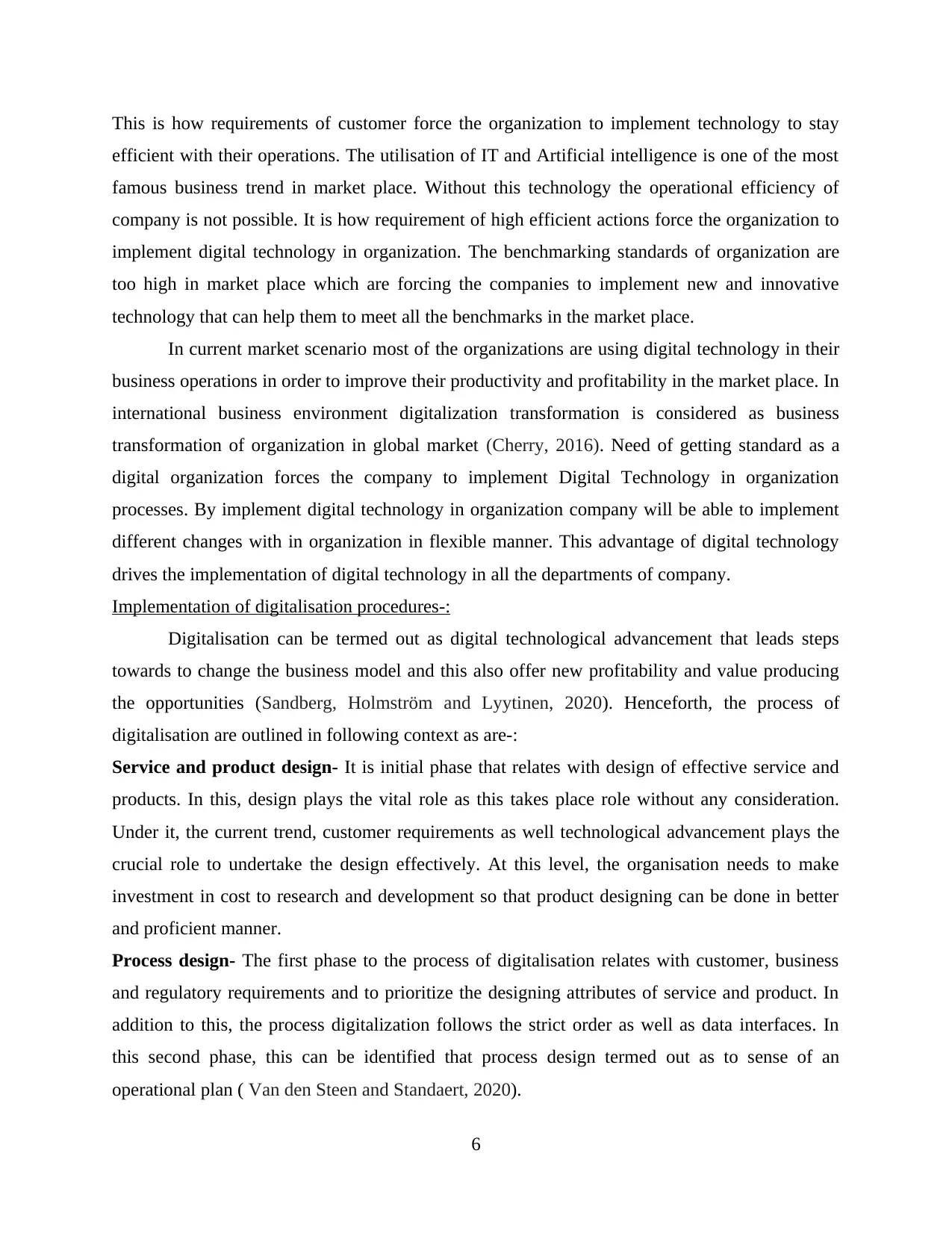
This is how requirements of customer force the organization to implement technology to stay
efficient with their operations. The utilisation of IT and Artificial intelligence is one of the most
famous business trend in market place. Without this technology the operational efficiency of
company is not possible. It is how requirement of high efficient actions force the organization to
implement digital technology in organization. The benchmarking standards of organization are
too high in market place which are forcing the companies to implement new and innovative
technology that can help them to meet all the benchmarks in the market place.
In current market scenario most of the organizations are using digital technology in their
business operations in order to improve their productivity and profitability in the market place. In
international business environment digitalization transformation is considered as business
transformation of organization in global market (Cherry, 2016). Need of getting standard as a
digital organization forces the company to implement Digital Technology in organization
processes. By implement digital technology in organization company will be able to implement
different changes with in organization in flexible manner. This advantage of digital technology
drives the implementation of digital technology in all the departments of company.
Implementation of digitalisation procedures-:
Digitalisation can be termed out as digital technological advancement that leads steps
towards to change the business model and this also offer new profitability and value producing
the opportunities (Sandberg, Holmström and Lyytinen, 2020). Henceforth, the process of
digitalisation are outlined in following context as are-:
Service and product design- It is initial phase that relates with design of effective service and
products. In this, design plays the vital role as this takes place role without any consideration.
Under it, the current trend, customer requirements as well technological advancement plays the
crucial role to undertake the design effectively. At this level, the organisation needs to make
investment in cost to research and development so that product designing can be done in better
and proficient manner.
Process design- The first phase to the process of digitalisation relates with customer, business
and regulatory requirements and to prioritize the designing attributes of service and product. In
addition to this, the process digitalization follows the strict order as well as data interfaces. In
this second phase, this can be identified that process design termed out as to sense of an
operational plan ( Van den Steen and Standaert, 2020).
6
efficient with their operations. The utilisation of IT and Artificial intelligence is one of the most
famous business trend in market place. Without this technology the operational efficiency of
company is not possible. It is how requirement of high efficient actions force the organization to
implement digital technology in organization. The benchmarking standards of organization are
too high in market place which are forcing the companies to implement new and innovative
technology that can help them to meet all the benchmarks in the market place.
In current market scenario most of the organizations are using digital technology in their
business operations in order to improve their productivity and profitability in the market place. In
international business environment digitalization transformation is considered as business
transformation of organization in global market (Cherry, 2016). Need of getting standard as a
digital organization forces the company to implement Digital Technology in organization
processes. By implement digital technology in organization company will be able to implement
different changes with in organization in flexible manner. This advantage of digital technology
drives the implementation of digital technology in all the departments of company.
Implementation of digitalisation procedures-:
Digitalisation can be termed out as digital technological advancement that leads steps
towards to change the business model and this also offer new profitability and value producing
the opportunities (Sandberg, Holmström and Lyytinen, 2020). Henceforth, the process of
digitalisation are outlined in following context as are-:
Service and product design- It is initial phase that relates with design of effective service and
products. In this, design plays the vital role as this takes place role without any consideration.
Under it, the current trend, customer requirements as well technological advancement plays the
crucial role to undertake the design effectively. At this level, the organisation needs to make
investment in cost to research and development so that product designing can be done in better
and proficient manner.
Process design- The first phase to the process of digitalisation relates with customer, business
and regulatory requirements and to prioritize the designing attributes of service and product. In
addition to this, the process digitalization follows the strict order as well as data interfaces. In
this second phase, this can be identified that process design termed out as to sense of an
operational plan ( Van den Steen and Standaert, 2020).
6
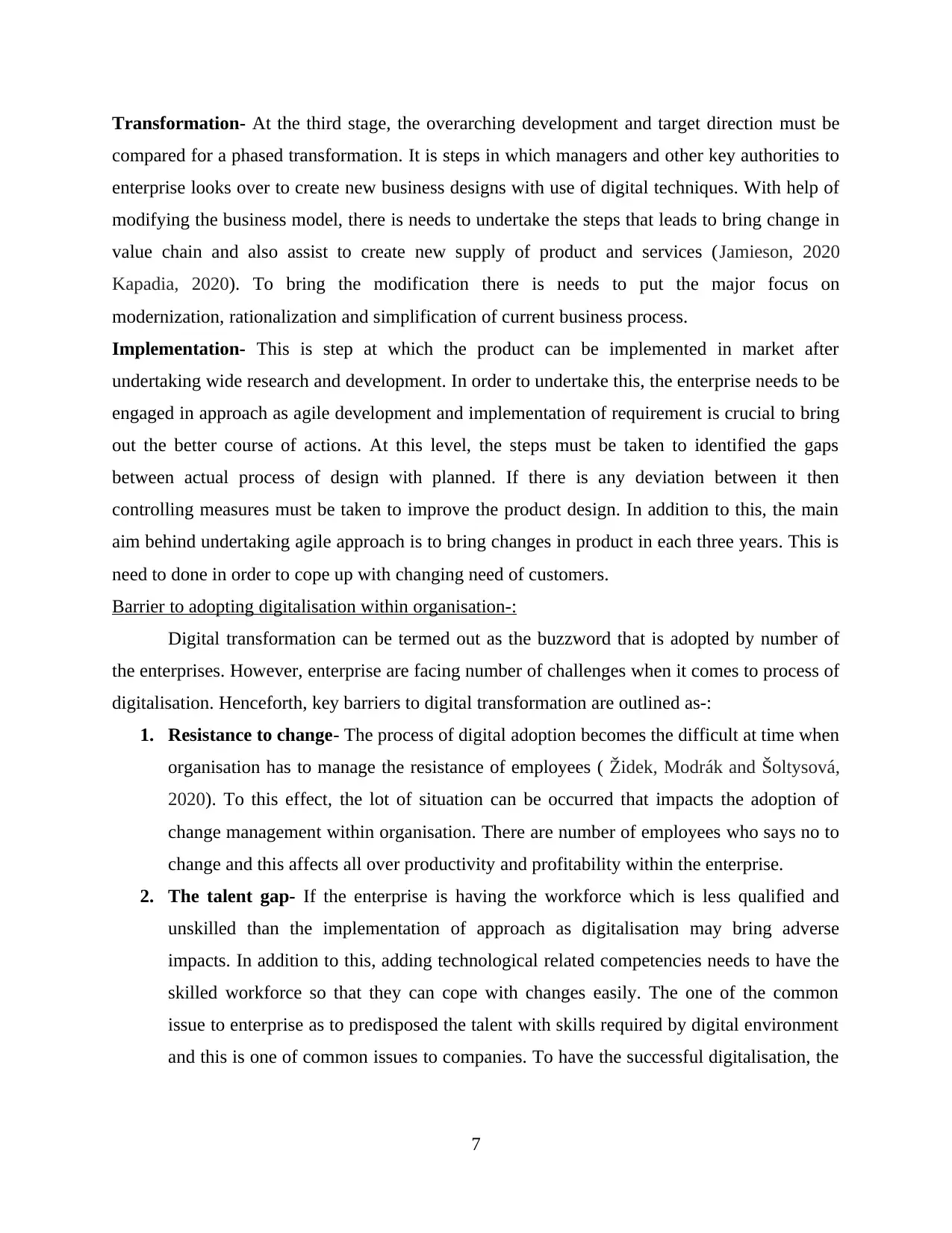
Transformation- At the third stage, the overarching development and target direction must be
compared for a phased transformation. It is steps in which managers and other key authorities to
enterprise looks over to create new business designs with use of digital techniques. With help of
modifying the business model, there is needs to undertake the steps that leads to bring change in
value chain and also assist to create new supply of product and services (Jamieson, 2020
Kapadia, 2020). To bring the modification there is needs to put the major focus on
modernization, rationalization and simplification of current business process.
Implementation- This is step at which the product can be implemented in market after
undertaking wide research and development. In order to undertake this, the enterprise needs to be
engaged in approach as agile development and implementation of requirement is crucial to bring
out the better course of actions. At this level, the steps must be taken to identified the gaps
between actual process of design with planned. If there is any deviation between it then
controlling measures must be taken to improve the product design. In addition to this, the main
aim behind undertaking agile approach is to bring changes in product in each three years. This is
need to done in order to cope up with changing need of customers.
Barrier to adopting digitalisation within organisation-:
Digital transformation can be termed out as the buzzword that is adopted by number of
the enterprises. However, enterprise are facing number of challenges when it comes to process of
digitalisation. Henceforth, key barriers to digital transformation are outlined as-:
1. Resistance to change- The process of digital adoption becomes the difficult at time when
organisation has to manage the resistance of employees ( Židek, Modrák and Šoltysová,
2020). To this effect, the lot of situation can be occurred that impacts the adoption of
change management within organisation. There are number of employees who says no to
change and this affects all over productivity and profitability within the enterprise.
2. The talent gap- If the enterprise is having the workforce which is less qualified and
unskilled than the implementation of approach as digitalisation may bring adverse
impacts. In addition to this, adding technological related competencies needs to have the
skilled workforce so that they can cope with changes easily. The one of the common
issue to enterprise as to predisposed the talent with skills required by digital environment
and this is one of common issues to companies. To have the successful digitalisation, the
7
compared for a phased transformation. It is steps in which managers and other key authorities to
enterprise looks over to create new business designs with use of digital techniques. With help of
modifying the business model, there is needs to undertake the steps that leads to bring change in
value chain and also assist to create new supply of product and services (Jamieson, 2020
Kapadia, 2020). To bring the modification there is needs to put the major focus on
modernization, rationalization and simplification of current business process.
Implementation- This is step at which the product can be implemented in market after
undertaking wide research and development. In order to undertake this, the enterprise needs to be
engaged in approach as agile development and implementation of requirement is crucial to bring
out the better course of actions. At this level, the steps must be taken to identified the gaps
between actual process of design with planned. If there is any deviation between it then
controlling measures must be taken to improve the product design. In addition to this, the main
aim behind undertaking agile approach is to bring changes in product in each three years. This is
need to done in order to cope up with changing need of customers.
Barrier to adopting digitalisation within organisation-:
Digital transformation can be termed out as the buzzword that is adopted by number of
the enterprises. However, enterprise are facing number of challenges when it comes to process of
digitalisation. Henceforth, key barriers to digital transformation are outlined as-:
1. Resistance to change- The process of digital adoption becomes the difficult at time when
organisation has to manage the resistance of employees ( Židek, Modrák and Šoltysová,
2020). To this effect, the lot of situation can be occurred that impacts the adoption of
change management within organisation. There are number of employees who says no to
change and this affects all over productivity and profitability within the enterprise.
2. The talent gap- If the enterprise is having the workforce which is less qualified and
unskilled than the implementation of approach as digitalisation may bring adverse
impacts. In addition to this, adding technological related competencies needs to have the
skilled workforce so that they can cope with changes easily. The one of the common
issue to enterprise as to predisposed the talent with skills required by digital environment
and this is one of common issues to companies. To have the successful digitalisation, the
7
⊘ This is a preview!⊘
Do you want full access?
Subscribe today to unlock all pages.

Trusted by 1+ million students worldwide
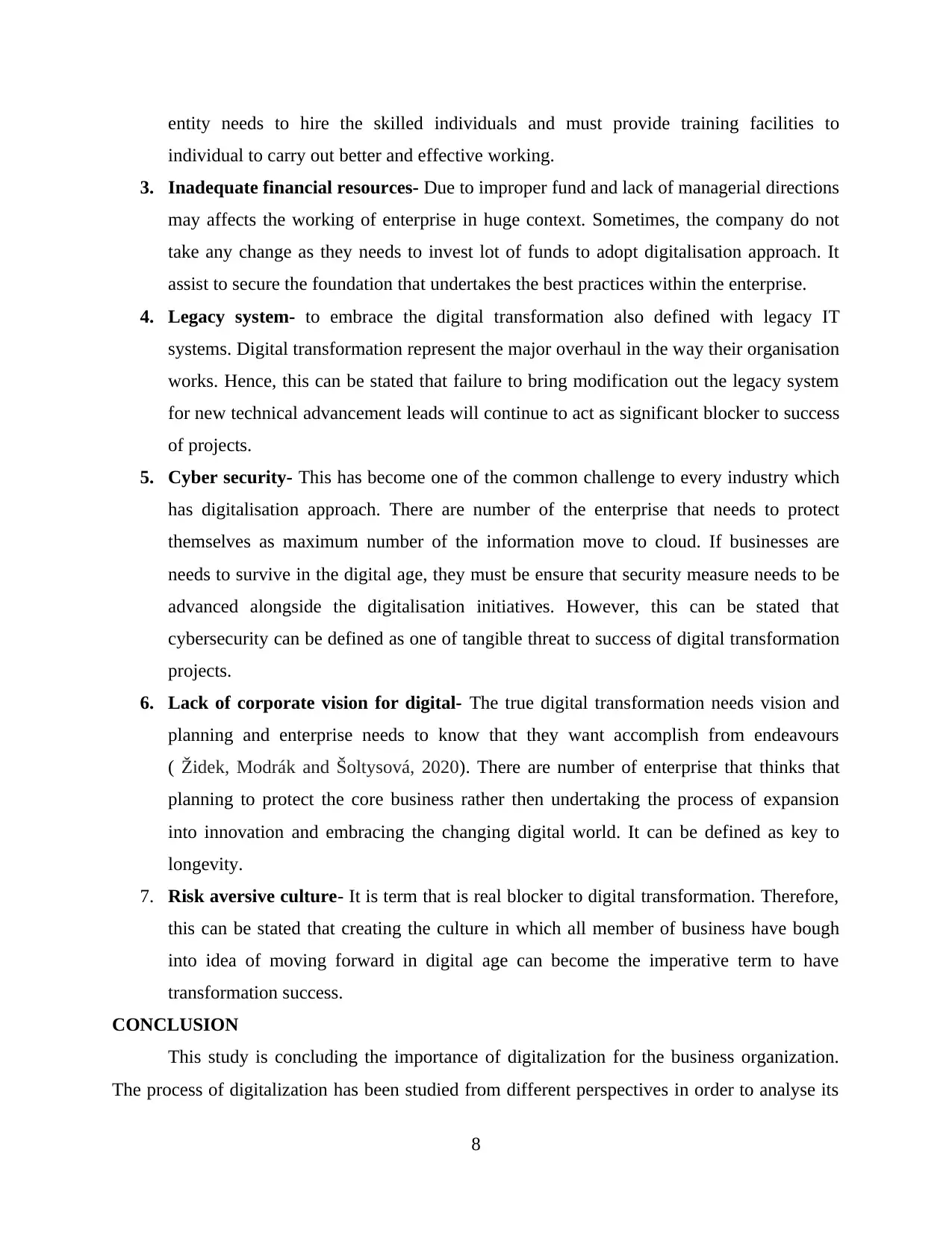
entity needs to hire the skilled individuals and must provide training facilities to
individual to carry out better and effective working.
3. Inadequate financial resources- Due to improper fund and lack of managerial directions
may affects the working of enterprise in huge context. Sometimes, the company do not
take any change as they needs to invest lot of funds to adopt digitalisation approach. It
assist to secure the foundation that undertakes the best practices within the enterprise.
4. Legacy system- to embrace the digital transformation also defined with legacy IT
systems. Digital transformation represent the major overhaul in the way their organisation
works. Hence, this can be stated that failure to bring modification out the legacy system
for new technical advancement leads will continue to act as significant blocker to success
of projects.
5. Cyber security- This has become one of the common challenge to every industry which
has digitalisation approach. There are number of the enterprise that needs to protect
themselves as maximum number of the information move to cloud. If businesses are
needs to survive in the digital age, they must be ensure that security measure needs to be
advanced alongside the digitalisation initiatives. However, this can be stated that
cybersecurity can be defined as one of tangible threat to success of digital transformation
projects.
6. Lack of corporate vision for digital- The true digital transformation needs vision and
planning and enterprise needs to know that they want accomplish from endeavours
( Židek, Modrák and Šoltysová, 2020). There are number of enterprise that thinks that
planning to protect the core business rather then undertaking the process of expansion
into innovation and embracing the changing digital world. It can be defined as key to
longevity.
7. Risk aversive culture- It is term that is real blocker to digital transformation. Therefore,
this can be stated that creating the culture in which all member of business have bough
into idea of moving forward in digital age can become the imperative term to have
transformation success.
CONCLUSION
This study is concluding the importance of digitalization for the business organization.
The process of digitalization has been studied from different perspectives in order to analyse its
8
individual to carry out better and effective working.
3. Inadequate financial resources- Due to improper fund and lack of managerial directions
may affects the working of enterprise in huge context. Sometimes, the company do not
take any change as they needs to invest lot of funds to adopt digitalisation approach. It
assist to secure the foundation that undertakes the best practices within the enterprise.
4. Legacy system- to embrace the digital transformation also defined with legacy IT
systems. Digital transformation represent the major overhaul in the way their organisation
works. Hence, this can be stated that failure to bring modification out the legacy system
for new technical advancement leads will continue to act as significant blocker to success
of projects.
5. Cyber security- This has become one of the common challenge to every industry which
has digitalisation approach. There are number of the enterprise that needs to protect
themselves as maximum number of the information move to cloud. If businesses are
needs to survive in the digital age, they must be ensure that security measure needs to be
advanced alongside the digitalisation initiatives. However, this can be stated that
cybersecurity can be defined as one of tangible threat to success of digital transformation
projects.
6. Lack of corporate vision for digital- The true digital transformation needs vision and
planning and enterprise needs to know that they want accomplish from endeavours
( Židek, Modrák and Šoltysová, 2020). There are number of enterprise that thinks that
planning to protect the core business rather then undertaking the process of expansion
into innovation and embracing the changing digital world. It can be defined as key to
longevity.
7. Risk aversive culture- It is term that is real blocker to digital transformation. Therefore,
this can be stated that creating the culture in which all member of business have bough
into idea of moving forward in digital age can become the imperative term to have
transformation success.
CONCLUSION
This study is concluding the importance of digitalization for the business organization.
The process of digitalization has been studied from different perspectives in order to analyse its
8
Paraphrase This Document
Need a fresh take? Get an instant paraphrase of this document with our AI Paraphraser
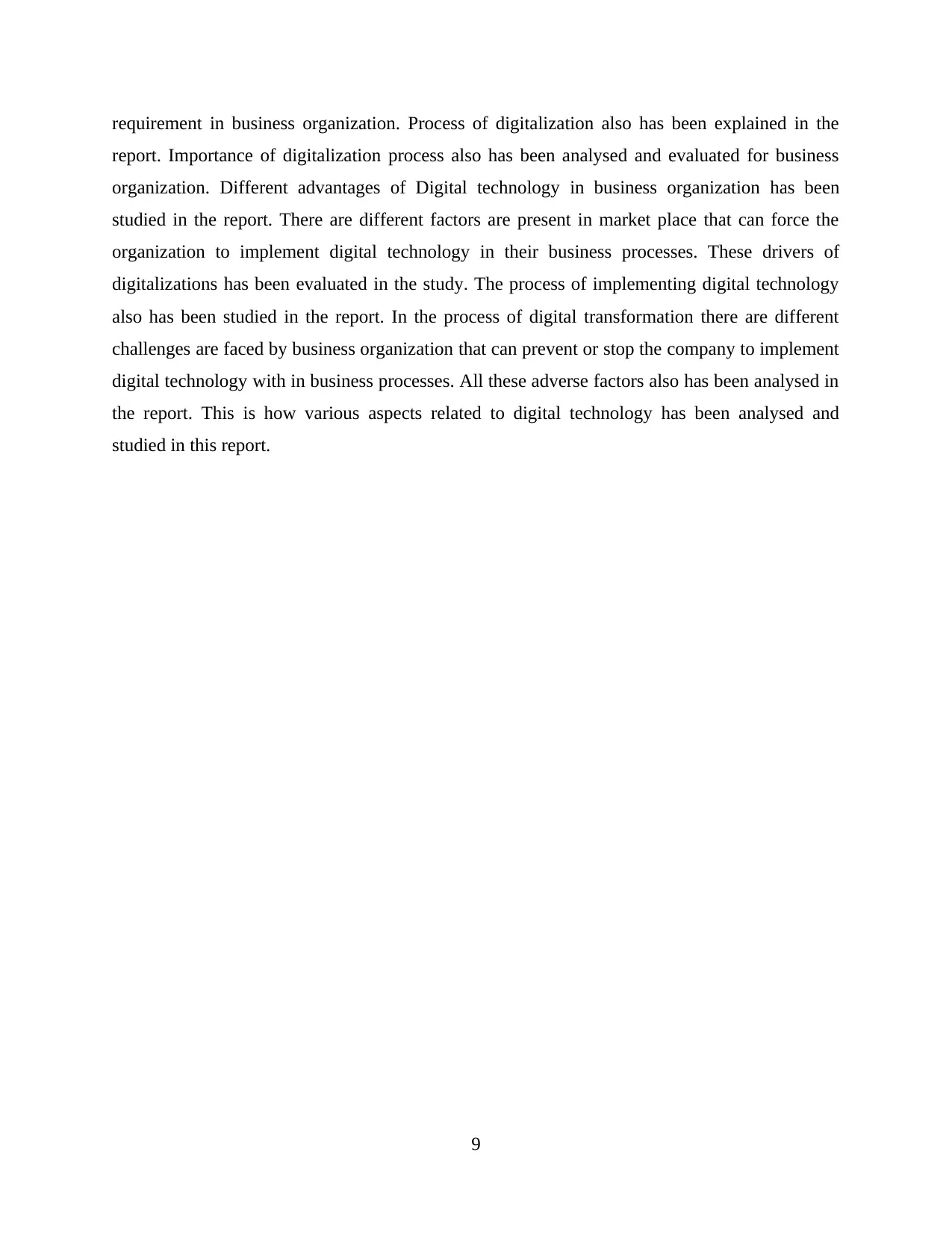
requirement in business organization. Process of digitalization also has been explained in the
report. Importance of digitalization process also has been analysed and evaluated for business
organization. Different advantages of Digital technology in business organization has been
studied in the report. There are different factors are present in market place that can force the
organization to implement digital technology in their business processes. These drivers of
digitalizations has been evaluated in the study. The process of implementing digital technology
also has been studied in the report. In the process of digital transformation there are different
challenges are faced by business organization that can prevent or stop the company to implement
digital technology with in business processes. All these adverse factors also has been analysed in
the report. This is how various aspects related to digital technology has been analysed and
studied in this report.
9
report. Importance of digitalization process also has been analysed and evaluated for business
organization. Different advantages of Digital technology in business organization has been
studied in the report. There are different factors are present in market place that can force the
organization to implement digital technology in their business processes. These drivers of
digitalizations has been evaluated in the study. The process of implementing digital technology
also has been studied in the report. In the process of digital transformation there are different
challenges are faced by business organization that can prevent or stop the company to implement
digital technology with in business processes. All these adverse factors also has been analysed in
the report. This is how various aspects related to digital technology has been analysed and
studied in this report.
9
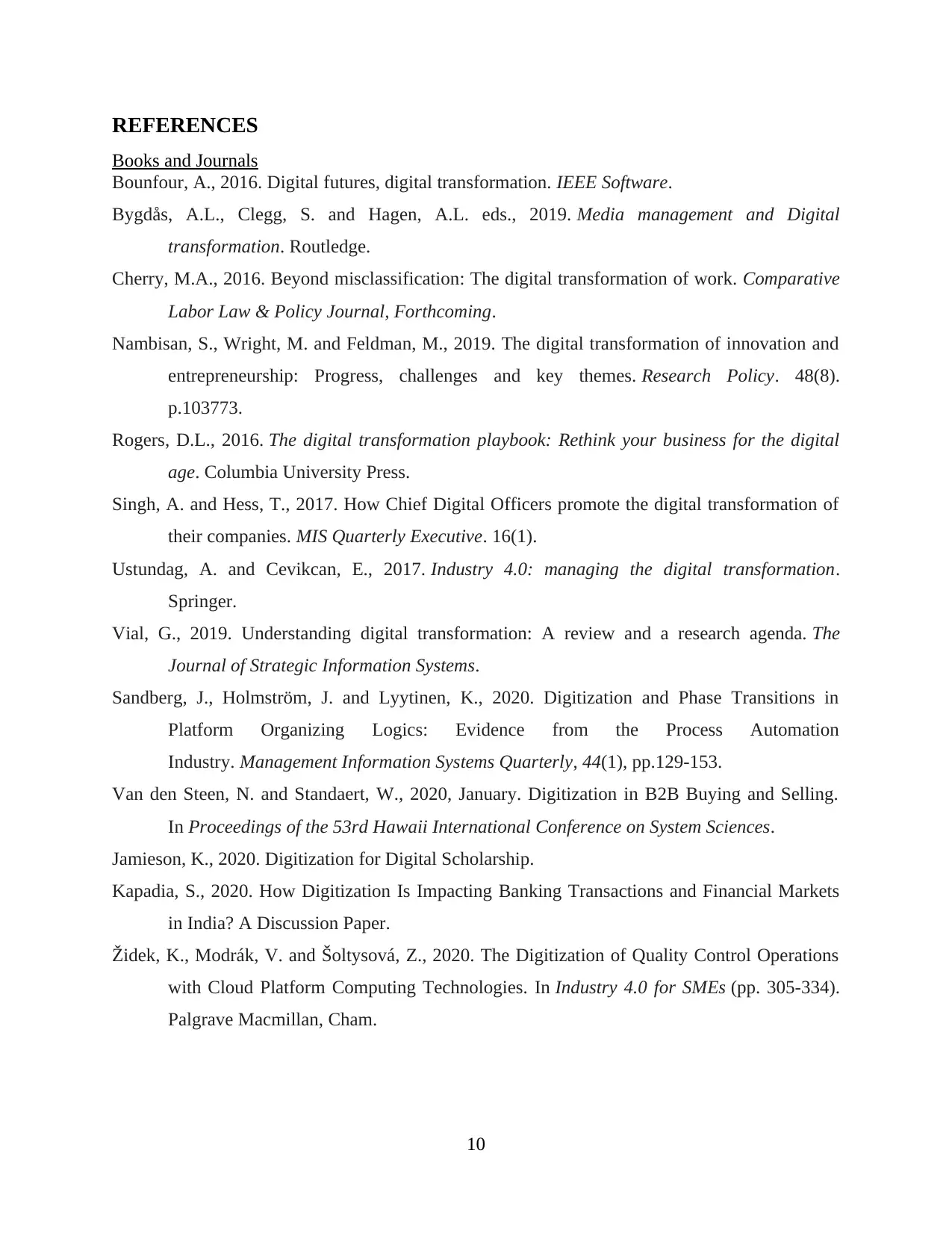
REFERENCES
Books and Journals
Bounfour, A., 2016. Digital futures, digital transformation. IEEE Software.
Bygdås, A.L., Clegg, S. and Hagen, A.L. eds., 2019. Media management and Digital
transformation. Routledge.
Cherry, M.A., 2016. Beyond misclassification: The digital transformation of work. Comparative
Labor Law & Policy Journal, Forthcoming.
Nambisan, S., Wright, M. and Feldman, M., 2019. The digital transformation of innovation and
entrepreneurship: Progress, challenges and key themes. Research Policy. 48(8).
p.103773.
Rogers, D.L., 2016. The digital transformation playbook: Rethink your business for the digital
age. Columbia University Press.
Singh, A. and Hess, T., 2017. How Chief Digital Officers promote the digital transformation of
their companies. MIS Quarterly Executive. 16(1).
Ustundag, A. and Cevikcan, E., 2017. Industry 4.0: managing the digital transformation.
Springer.
Vial, G., 2019. Understanding digital transformation: A review and a research agenda. The
Journal of Strategic Information Systems.
Sandberg, J., Holmström, J. and Lyytinen, K., 2020. Digitization and Phase Transitions in
Platform Organizing Logics: Evidence from the Process Automation
Industry. Management Information Systems Quarterly, 44(1), pp.129-153.
Van den Steen, N. and Standaert, W., 2020, January. Digitization in B2B Buying and Selling.
In Proceedings of the 53rd Hawaii International Conference on System Sciences.
Jamieson, K., 2020. Digitization for Digital Scholarship.
Kapadia, S., 2020. How Digitization Is Impacting Banking Transactions and Financial Markets
in India? A Discussion Paper.
Židek, K., Modrák, V. and Šoltysová, Z., 2020. The Digitization of Quality Control Operations
with Cloud Platform Computing Technologies. In Industry 4.0 for SMEs (pp. 305-334).
Palgrave Macmillan, Cham.
10
Books and Journals
Bounfour, A., 2016. Digital futures, digital transformation. IEEE Software.
Bygdås, A.L., Clegg, S. and Hagen, A.L. eds., 2019. Media management and Digital
transformation. Routledge.
Cherry, M.A., 2016. Beyond misclassification: The digital transformation of work. Comparative
Labor Law & Policy Journal, Forthcoming.
Nambisan, S., Wright, M. and Feldman, M., 2019. The digital transformation of innovation and
entrepreneurship: Progress, challenges and key themes. Research Policy. 48(8).
p.103773.
Rogers, D.L., 2016. The digital transformation playbook: Rethink your business for the digital
age. Columbia University Press.
Singh, A. and Hess, T., 2017. How Chief Digital Officers promote the digital transformation of
their companies. MIS Quarterly Executive. 16(1).
Ustundag, A. and Cevikcan, E., 2017. Industry 4.0: managing the digital transformation.
Springer.
Vial, G., 2019. Understanding digital transformation: A review and a research agenda. The
Journal of Strategic Information Systems.
Sandberg, J., Holmström, J. and Lyytinen, K., 2020. Digitization and Phase Transitions in
Platform Organizing Logics: Evidence from the Process Automation
Industry. Management Information Systems Quarterly, 44(1), pp.129-153.
Van den Steen, N. and Standaert, W., 2020, January. Digitization in B2B Buying and Selling.
In Proceedings of the 53rd Hawaii International Conference on System Sciences.
Jamieson, K., 2020. Digitization for Digital Scholarship.
Kapadia, S., 2020. How Digitization Is Impacting Banking Transactions and Financial Markets
in India? A Discussion Paper.
Židek, K., Modrák, V. and Šoltysová, Z., 2020. The Digitization of Quality Control Operations
with Cloud Platform Computing Technologies. In Industry 4.0 for SMEs (pp. 305-334).
Palgrave Macmillan, Cham.
10
⊘ This is a preview!⊘
Do you want full access?
Subscribe today to unlock all pages.

Trusted by 1+ million students worldwide
1 out of 12
Related Documents
Your All-in-One AI-Powered Toolkit for Academic Success.
+13062052269
info@desklib.com
Available 24*7 on WhatsApp / Email
![[object Object]](/_next/static/media/star-bottom.7253800d.svg)
Unlock your academic potential
Copyright © 2020–2025 A2Z Services. All Rights Reserved. Developed and managed by ZUCOL.





